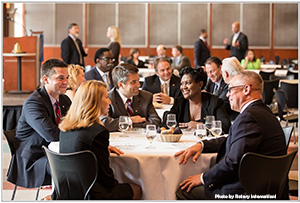The theme of Rotary International’s April 2019 Training Talk Newsletter is on “Diversity, equity and inclusion.” Just last week I addressed this topic by sharing in graphical form the principles inherent in Rotary’s policy statement. Because this topic is of such importance to our future as a Rotarian, I am sharing the contents of the April 2019 newsletter so that it gets as wide a distribution as possible.
The RI Board of Directors recently adopted a new diversity, equity, and inclusion statement:
“As a global network that strives to build a world where people unite and take action to create lasting change, Rotary values diversity and celebrates the contributions of people of all backgrounds, regardless of their age, ethnicity, race, color, abilities, religion, socioeconomic status, culture, sex, sexual orientation, and gender identity.
Rotary will cultivate a diverse, equitable, and inclusive culture in which people from underrepresented groups have greater opportunities to participate as members and leaders.”
Does your club reflect this statement? Assessing the culture of your club requires a willingness to talk openly about diversity and inclusion. Here are some ideas to help you get started:
- Discuss your club’s culture and whether it’s welcoming to all
- Look for biases in your club’s membership criteria
Evaluate your community’s perception of Rotary as well. Members who see their club as a safe space for jokes or comments that target a specific gender, race, or religion contradict Rotary’s values and create a public image liability.
Practice Conscious Inclusion
Conscious inclusion enables people to become aware of the perspectives and biases they may have.
 It gives them practical tools for creating an environment where people feel they belong and their voices are heard, and where diversity is valued and respected. Kaleidoscope Group, a consulting firm in Chicago, says that an environment of conscious inclusion can lead to innovation, superior work, stronger team performance, talent retention, new opportunities, and a positive reputation.
It gives them practical tools for creating an environment where people feel they belong and their voices are heard, and where diversity is valued and respected. Kaleidoscope Group, a consulting firm in Chicago, says that an environment of conscious inclusion can lead to innovation, superior work, stronger team performance, talent retention, new opportunities, and a positive reputation.You can lead by example. Create an environment that’s inclusive by modelling these practices in your training:
- Empathy
- Openness
- Trust
- Honest dialogue
- Valuing Differences
If you’re having trouble starting the conversation, invite someone who’s an expert on diversity and inclusion to speak at one of your meetings.
Resources
Visit the Learning Center and take the course on Building a Diverse Club. It includes an interactive module with scenarios and assessment tools you can share with your club leaders to measure their goals of becoming a more diverse and inclusive club.
You can also promote these resources to help clubs improve their recruitment strategies:
You can also promote these resources to help clubs improve their recruitment strategies:
Learn how Zones 7B and 8 are promoting these tools to create more inclusive club environments.
